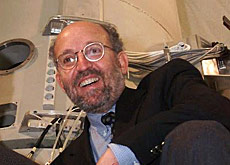Nasa gathers stardust from “Bernese” comet

The space probe Stardust has returned to earth after a seven-year journey to collect dust particles from the comet Wild 2.
The comet was named after its discoverer, the Bernese astronomy professor, Paul Wild.
“It was only a small whitish spot on the edge of a photograph,” Wild says of the object he saw for the first time on January 6, 1978.
The emeritus professor and former director of Bern University’s Astronomical Institute had seen such spots many times when he checked images of the night sky for changes.
“In 90 per cent of cases, the spots were mistakes in the film,” he said.
Star among comets
He hoped to do a follow-up observation a day later but the weather was too bad.
This continued for weeks – in the end, he had to wait three weeks after first spotting the fleck in the photograph to continue his investigations.
To his surprise, the spot was still there; it had just changed its position slightly. It became quickly clear that he had discovered a comet.
Comets are always named after their discoverers.
It was not his first and it would not be his last. But Wild 2 went on to become a star.
Mission Stardust
Wild 2 is on the move. It is presumed to have come into being and orbited for a long time at a much greater distance from the sun.
It must have taken its current course not long before it was discovered, during which it came close to the sun a few times. As it hasn’t been heated much by the sun, it still consists mostly of its original material.
A few years ago, the United States space agency, Nasa, chose Wild 2 as the destination for a space probe. Stardust was the first Nasa mission to examine comets.
“Of course it was very special for me that Nasa chose my comet for its mission,” Wild said.
Hi-tech
The 85-year-old astronomer was at Cape Canaveral when the probe blasted off into space in February 1999.
The probe’s task was to collect minute dust particles from the comet. The space agency even developed a special substance, called aerogel, to trap the particles and to protect them.
By analysing the dust, space researchers hope to learn more about the comet’s make-up and how the solar system came into being.
Two years ago, the space probe came within 240km of the comet and flew through its tail. During this period, the probe took photographs and sent them to earth.
“These images are better than we hoped for in our wildest dreams,” raved Nasa’s Ray Newburn.
Whether dust samples were successfully collected is still to be revealed.
Fastest object
After seven years and some 4.6 billion kilometres, Stardust’s capsule landed shortly before dawn in the desert of the US state of Utah.
The probe separated from the capsule around midnight, generating a speed which no other manmade object has ever achieved, says Nasa. A few hours later, the capsule entered the earth’s atmosphere and returned to land attached to a parachute.
The capsule also carried a letter, written by Wild, which accompanied the probe on its journey into space.
swissinfo, Antoinette Schwab
Stardust timeline
February 7, 1999 – launch from Cape Canaveral
February-May 2000 – first interstellar dust collection
January 15, 2001 – closest approach to earth.

In compliance with the JTI standards
More: SWI swissinfo.ch certified by the Journalism Trust Initiative











You can find an overview of ongoing debates with our journalists here . Please join us!
If you want to start a conversation about a topic raised in this article or want to report factual errors, email us at english@swissinfo.ch.